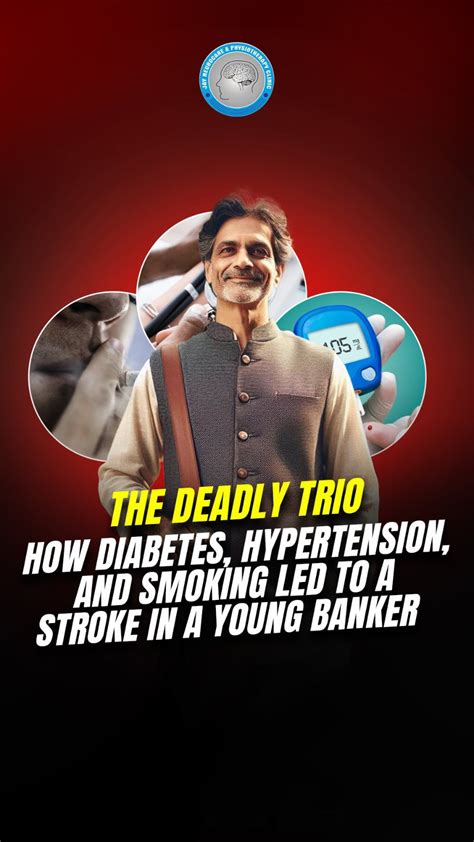
A seemingly innocuous neck movement triggered a stroke in a 40-year-old man, highlighting the potential dangers of vertebral artery dissection and the critical importance of stroke awareness, particularly among younger adults.
Man’s Stroke at 40 Linked to Neck Movement; Emphasizes Stroke Awareness
A 40-year-old stroke survivor is sharing his story to raise awareness about the often-overlooked causes of stroke, especially in younger individuals. The man, identified only as “Richard” in the original article, suffered a stroke caused by vertebral artery dissection (VAD), a condition where a tear occurs in the inner lining of one of the vertebral arteries in the neck, potentially leading to blood clot formation and subsequent stroke. In Richard’s case, the triggering event was a seemingly harmless turn of the head.
Richard’s experience underscores that stroke isn’t solely a concern for the elderly; younger adults are also vulnerable. He now advocates for increased awareness of stroke symptoms and risk factors to improve early detection and treatment, which are crucial for minimizing long-term disability. His journey serves as a stark reminder that recognizing the warning signs and acting swiftly can be the difference between life and death, or a full recovery and lasting impairment.
The Unexpected Trigger: Vertebral Artery Dissection
Vertebral artery dissection is a significant cause of stroke, particularly in younger individuals, often occurring after trauma to the neck, such as a car accident, chiropractic manipulation, or, as in Richard’s case, a seemingly minor neck movement. These dissections can lead to the formation of blood clots, which can then travel to the brain, blocking blood flow and causing an ischemic stroke. According to medical professionals, “The vertebral arteries are located in the neck and supply blood to the brain. A dissection is a tear in the wall of the artery.”
While VAD can be triggered by significant trauma, it’s also been linked to everyday activities. This highlights the importance of being aware of potential neck injuries, even seemingly minor ones, and seeking medical attention if any stroke symptoms develop. The rarity of VAD following minor movements makes it difficult to predict, further emphasizing the need for heightened vigilance and rapid response to potential stroke indicators. The fact that something as simple as turning one’s head can trigger such a serious event underscores the fragility of the vascular system and the importance of preventative measures whenever possible.
Recognizing the Warning Signs: Time is Brain
The core message of Richard’s story is the critical need for stroke awareness. The American Stroke Association uses the acronym F.A.S.T. to help people remember the warning signs:
- Face drooping: Does one side of the face droop or is it numb? Ask the person to smile.
- Arm weakness: Is one arm weak or numb? Ask the person to raise both arms. Does one arm drift downward?
- Speech difficulty: Is speech slurred? Is the person unable to speak or hard to understand? Ask the person to repeat a simple sentence, like “The sky is blue.”
- Time to call 911: If someone shows any of these symptoms, even if the symptoms go away, call 911 and get the person to the hospital immediately.
Other stroke symptoms may include sudden:
- Numbness or weakness of the leg
- Confusion, trouble speaking or understanding
- Trouble seeing in one or both eyes
- Trouble walking, dizziness, loss of balance or coordination
- Severe headache with no known cause
Recognizing these symptoms and acting quickly is paramount. “Time is brain” is a common saying among stroke specialists, emphasizing that the longer a stroke goes untreated, the more brain cells die, leading to potentially irreversible damage. The faster a person receives medical attention, the greater their chance of recovery.
Treatment Options: Restoring Blood Flow
The primary goal of stroke treatment is to restore blood flow to the brain as quickly as possible. The specific treatment depends on the type of stroke and the time elapsed since the onset of symptoms. For ischemic strokes, the most common type, treatment options include:
- Thrombolytics (tPA): This medication, also known as a “clot-busting” drug, can dissolve blood clots and restore blood flow to the brain. However, it must be administered within a specific timeframe (usually within 3 to 4.5 hours) of symptom onset to be effective.
- Endovascular Procedures: These procedures involve inserting a catheter into an artery, usually in the groin, and guiding it to the blocked artery in the brain. A device can then be used to remove the clot and restore blood flow. This is often used for large vessel occlusions (LVOs), where a major artery in the brain is blocked.
- Antiplatelet and Anticoagulant Medications: These medications, such as aspirin or warfarin, can help prevent further clot formation and reduce the risk of future strokes. They are often prescribed after a stroke to prevent recurrence.
In Richard’s case, the prompt medical intervention he received likely played a significant role in his survival and recovery. Access to timely and appropriate treatment is crucial for improving outcomes for stroke patients.
Risk Factors and Prevention: Addressing Modifiable Risks
While some risk factors for stroke, such as age and family history, are non-modifiable, many others can be addressed through lifestyle changes and medical management. Modifiable risk factors for stroke include:
- High Blood Pressure: Hypertension is a major risk factor for stroke. Controlling blood pressure through diet, exercise, and medication can significantly reduce stroke risk.
- High Cholesterol: High cholesterol levels can contribute to the buildup of plaque in the arteries, increasing the risk of blood clots and stroke. Lifestyle changes and medication can help lower cholesterol levels.
- Smoking: Smoking damages blood vessels and increases the risk of blood clots. Quitting smoking is one of the most effective ways to reduce stroke risk.
- Diabetes: Diabetes increases the risk of stroke by damaging blood vessels and increasing the risk of blood clots. Managing blood sugar levels through diet, exercise, and medication is crucial for reducing stroke risk.
- Obesity: Obesity is associated with increased risk of high blood pressure, high cholesterol, diabetes, and other risk factors for stroke. Maintaining a healthy weight through diet and exercise can help reduce stroke risk.
- Physical Inactivity: Lack of physical activity increases the risk of high blood pressure, high cholesterol, diabetes, and obesity. Regular exercise can help reduce stroke risk.
- Atrial Fibrillation: This irregular heartbeat increases the risk of blood clots and stroke. Medication and other treatments can help manage atrial fibrillation and reduce stroke risk.
- Unhealthy Diet: A diet high in saturated and trans fats, cholesterol, and sodium can increase the risk of high blood pressure, high cholesterol, and obesity. A healthy diet rich in fruits, vegetables, and whole grains can help reduce stroke risk.
- Excessive Alcohol Consumption: Heavy alcohol consumption can increase the risk of high blood pressure, atrial fibrillation, and stroke. Moderate alcohol consumption or abstinence is recommended.
- Drug Use: Certain drugs, such as cocaine and methamphetamine, can increase the risk of stroke. Avoiding drug use is essential for reducing stroke risk.
Taking steps to manage these risk factors can significantly reduce the likelihood of experiencing a stroke. Regular check-ups with a healthcare provider are also important for monitoring risk factors and detecting potential problems early.
The Impact of Stroke: Long-Term Effects and Rehabilitation
Stroke can have a devastating impact on individuals and their families. The long-term effects of stroke can vary depending on the severity and location of the brain damage, but may include:
- Paralysis or Weakness: Stroke can cause paralysis or weakness on one side of the body, making it difficult to move or perform everyday tasks.
- Speech and Language Problems: Stroke can affect speech and language abilities, making it difficult to speak, understand, read, or write.
- Cognitive Impairments: Stroke can cause problems with memory, attention, problem-solving, and other cognitive functions.
- Emotional Difficulties: Stroke can lead to emotional changes, such as depression, anxiety, and irritability.
- Pain and Sensory Changes: Stroke can cause pain, numbness, tingling, or other sensory changes.
- Swallowing Problems: Stroke can affect the muscles involved in swallowing, making it difficult to eat and drink safely.
- Vision Problems: Stroke can cause vision loss, double vision, or other visual disturbances.
Rehabilitation plays a crucial role in helping stroke survivors regain function and improve their quality of life. Stroke rehabilitation programs typically involve a multidisciplinary team of healthcare professionals, including physical therapists, occupational therapists, speech-language pathologists, and rehabilitation physicians. The goal of rehabilitation is to help stroke survivors regain as much independence as possible and adapt to any remaining disabilities. Therapies can include physical therapy to improve motor skills and mobility, occupational therapy to improve daily living skills, and speech therapy to improve communication and swallowing. Emotional support and counseling are also important aspects of stroke rehabilitation.
The Bigger Picture: Stroke Statistics and Public Health Implications
Stroke is a leading cause of death and disability in the United States and worldwide. According to the Centers for Disease Control and Prevention (CDC):
- About 795,000 people in the United States have a stroke each year.
- Stroke accounts for about 1 of every 19 deaths in the United States.
- Stroke is a leading cause of long-term disability.
- About 87% of all strokes are ischemic strokes.
These statistics highlight the significant public health burden of stroke. Increased awareness of stroke risk factors, symptoms, and treatment options is essential for reducing the incidence and impact of stroke. Public health initiatives aimed at promoting healthy lifestyles, controlling risk factors, and improving access to stroke care are crucial for addressing this major health challenge. Furthermore, funding for stroke research is needed to develop new and improved treatments for stroke.
The Importance of Advocacy: Sharing Stories and Raising Awareness
Richard’s decision to share his story is a powerful example of advocacy. By raising awareness about the potential dangers of vertebral artery dissection and the importance of stroke awareness, he is helping to educate others and potentially save lives. Stroke survivors and their families can play a vital role in advocating for increased stroke awareness, improved stroke care, and funding for stroke research. Sharing personal stories, participating in advocacy campaigns, and supporting stroke organizations are all ways to make a difference. The collective efforts of individuals, healthcare professionals, and organizations are essential for reducing the burden of stroke and improving outcomes for stroke patients. Awareness campaigns can focus on educating the public about stroke symptoms and risk factors, promoting healthy lifestyles, and advocating for policies that support stroke prevention and treatment.
The story of Richard serves as a critical reminder that stroke can affect anyone, at any age. Being proactive about understanding stroke, knowing the warning signs, and seeking immediate medical attention can significantly improve the chances of survival and recovery.
FAQ: Frequently Asked Questions About Stroke and Vertebral Artery Dissection
- What is vertebral artery dissection (VAD)?
Vertebral artery dissection (VAD) is a tear in the inner lining of one of the vertebral arteries, which are major blood vessels in the neck that supply blood to the brain. This tear can lead to blood clot formation, which can then travel to the brain and cause a stroke. VAD is a relatively uncommon cause of stroke, but it is more common in younger adults.
- What are the symptoms of vertebral artery dissection?
Symptoms of vertebral artery dissection can vary, but may include:
- Headache (often described as a severe or unusual headache)
- Neck pain
- Dizziness or vertigo
- Double vision
- Numbness or weakness
- Difficulty speaking or swallowing
- Stroke symptoms (such as facial drooping, arm weakness, or speech difficulty)
If you experience any of these symptoms, especially if they occur suddenly or are accompanied by other stroke symptoms, seek immediate medical attention.
- What causes vertebral artery dissection?
Vertebral artery dissection can be caused by trauma to the neck, such as a car accident, chiropractic manipulation, or even seemingly minor neck movements. In some cases, the cause of VAD is unknown. Certain underlying conditions, such as connective tissue disorders, may also increase the risk of VAD.
- How is vertebral artery dissection diagnosed?
Vertebral artery dissection is typically diagnosed using imaging tests, such as:
- CT angiography (CTA): A CT scan that uses contrast dye to visualize the blood vessels.
- Magnetic resonance angiography (MRA): An MRI scan that visualizes the blood vessels.
- Ultrasound: An ultrasound of the neck can sometimes detect VAD.
- What is the treatment for vertebral artery dissection?
The treatment for vertebral artery dissection typically involves medications to prevent blood clot formation, such as:
- Antiplatelet medications (such as aspirin)
- Anticoagulant medications (such as heparin or warfarin)
In some cases, endovascular procedures may be necessary to repair the damaged artery or remove a blood clot. The specific treatment will depend on the severity of the dissection and the presence of any complications. Early diagnosis and treatment are crucial for improving outcomes.
- Is stroke only a problem for older people?
No, stroke can occur at any age. While the risk of stroke increases with age, younger adults can also experience stroke. It’s important for people of all ages to be aware of the risk factors for stroke and the warning signs.
- What are the main risk factors for stroke?
Major risk factors include high blood pressure, high cholesterol, smoking, diabetes, obesity, physical inactivity, atrial fibrillation, unhealthy diet, excessive alcohol consumption, and drug use. Some risk factors, like age and family history, can’t be changed.
- What does the acronym F.A.S.T. stand for?
F.A.S.T. is an acronym used to help people remember the warning signs of stroke:
- Face drooping: Does one side of the face droop or is it numb?
- Arm weakness: Is one arm weak or numb?
- Speech difficulty: Is speech slurred?
- Time to call 911: If someone shows any of these symptoms, call 911 immediately.
- What should I do if I suspect someone is having a stroke?
Call 911 immediately. Do not try to drive the person to the hospital yourself. Emergency medical services can provide immediate care and transport the person to the nearest stroke center. The faster a person receives medical attention, the better their chance of recovery. Note the time when the first symptoms appeared, as this information is critical for determining the appropriate treatment.
- What types of long-term effects can stroke cause?
Stroke can cause a variety of long-term effects, including paralysis or weakness, speech and language problems, cognitive impairments, emotional difficulties, pain and sensory changes, swallowing problems, and vision problems. The specific effects will depend on the severity and location of the brain damage. Rehabilitation can help stroke survivors regain function and improve their quality of life.
- What is the role of rehabilitation after a stroke?
Rehabilitation is a crucial part of stroke recovery. It helps survivors regain lost function and learn to adapt to any remaining disabilities. A stroke rehabilitation program typically includes physical therapy, occupational therapy, and speech therapy, as well as emotional support and counseling. The goal of rehabilitation is to help stroke survivors achieve as much independence as possible and improve their quality of life.
- How can I reduce my risk of stroke?
You can reduce your risk of stroke by:
- Controlling high blood pressure
- Lowering high cholesterol
- Quitting smoking
- Managing diabetes
- Maintaining a healthy weight
- Being physically active
- Eating a healthy diet
- Limiting alcohol consumption
- Avoiding drug use
- Managing atrial fibrillation
- Getting regular check-ups with your doctor
- What is the difference between an ischemic stroke and a hemorrhagic stroke?
An ischemic stroke is caused by a blockage in an artery that supplies blood to the brain. A hemorrhagic stroke is caused by bleeding in the brain. Ischemic strokes are much more common than hemorrhagic strokes, accounting for about 87% of all strokes. The treatment for ischemic and hemorrhagic strokes is different, so it is important to determine the type of stroke as quickly as possible.
- What is a transient ischemic attack (TIA)?
A transient ischemic attack (TIA), also known as a “mini-stroke,” is a brief episode of stroke symptoms that lasts only a few minutes to a few hours. A TIA is caused by a temporary blockage of blood flow to the brain. While the symptoms of a TIA resolve quickly, it is a warning sign that a person is at increased risk of having a stroke in the future. Anyone who experiences a TIA should seek immediate medical attention.
- Are there any support groups for stroke survivors and their families?
Yes, there are many support groups available for stroke survivors and their families. These groups can provide a sense of community, emotional support, and practical advice. Your doctor or local hospital can provide information about support groups in your area. Organizations like the American Stroke Association also offer online support communities and resources.









